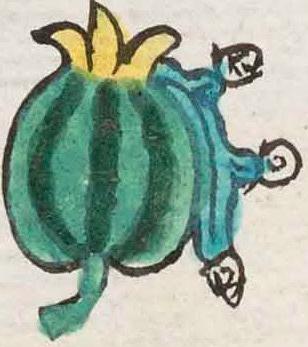Ayoxochapan (Mdz24v)
This compound glyph for the place name Ayoxochapan has three principal visual components, a flower (xochitl or xōchitl, recognizing the vowel length], a squash (ayotli or ayohtli), and a stream of water (atl) or ātl). The flower, consisting of three yellow petals pointing upward, is merged with the upright, two-tone green, striped squash. The water (meant to provide the phonetic clue to the locative suffix -apan, at or on the waters of) is typically painted turquoise with lines of current. It flows over and down the squash from the site of the flower. Splashing off the water are two white turbinate shells and a droplet (or precious jade stone), also white.
Stephanie Wood
The water possibly has a dual purpose, not only only providing the -apan (locative suffix), but also the phonetic A- that starts the place name, even though the ayotli also provides this. The overall reference seems to be to a place known for squash blossoms, but also where there would be a river or other body of water. Karttunen suggests a lake.
Stephanie Wood
ayoxochapā.puo
Ayoxochapan, pueblo
Stephanie Wood
c. 1541, or by 1553 at the latest
Stephanie Wood
squash blossoms, flowers, vegetables, food, flores de calabaza, comida, vegetales, nombres de lugares

ayo(tli) or ayoh(tli) , squash, https://nahuatl.wired-humanities.org/content/ayotli
a(tl) or ā(tl), water, https://nahuatl.wired-humanities.org/conent/atl
xoch(itl) or xōch(itl), flower(s), https://nahuatl.wired-humanities.org/content/xochitl
-apan (locative suffix), on or at the waters of, https://nahuatl.wired-humanities.org/content/apan-0
"On Squash Blossom Lake" [Frances Karttunen, "Critique of glyph catalogue in Berdan and Anawalt edition of Codex Mendoza," unpublished manuscript, used here with her permission.]
"On the Water of the Gourd Flower" (Berdan and Anawalt, 1992, vol. 1, p. 174)
"En al Agua (Lago?) de la Flor de Calabaza"
Stephanie Wood
Codex Mendoza, folio 24 verso, https://digital.bodleian.ox.ac.uk/objects/2fea788e-2aa2-4f08-b6d9-648c00..., image 59 of 188.
The Bodleian Libraries, University of Oxford, hold the original manuscript, the MS. Arch. Selden. A. 1. This image is published here under the UK Creative Commons, “Attribution-NonCommercial-ShareAlike 3.0 License” (CC-BY-NC-SA 3.0).

